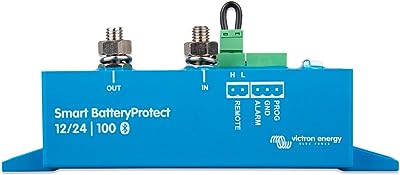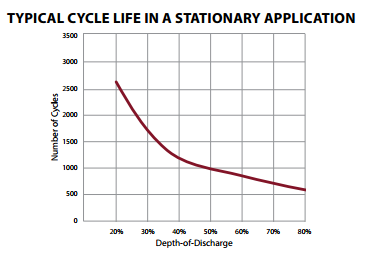Table of Contents
Low Voltage Disconnect (LVD)
A low voltage disconnect is used to stop loads from dragging a battery bank below a given voltage (Vlvd).
examples
One can also DIY a low voltage disconnect.
In theory the simplest way to implement an LVD would be to wire all loads go through the LOAD output of the charge controller, and set the controller's Vlvd. In practice this is rarely done for reasons given in the link above. It is more common to run a relay on the LOAD output, which is triggered ON/OFF by the LVD setting:
controller LOAD output → relay → loads1)
If the controller has no LVD (or not no LOAD output at all) you can use a stand-alone LVD powered by the battery.
common LVD setpoints
Lead-acid deep cycle batteries are typically discharged 50% Depth of Discharge or less 2). That point is somewhere around 12.20v when rested or very lightly loaded.
This following chart3) shows DoD vs expected duty cycles. In an offgrid scenario we will assume the bank is cycled every night. If the bank is drained to the usual 50% DoD the bank4) is predicted to last 1000 cycles, or about 3 years. If the bank cycle is shallower to 20% DoD the bank is expected to last 2500 cycles, or about 7.5 years. If the bank is deeply cycled to 80% DoD the bank is expected to last 500 cycles, or about 1.5 years.
The sweet spot appears to be 40% DoD based on the graph.
LiFePO4 nominal 12v banks can be safely drained to 80-90% Depth of Discharge. That point is something like 12.0v.5)
challenges
LVD rely on measured voltage to know when to disconnect, but heavy loads can cause distortions (voltage sag) in that reading.
| State of Charge | Voltage, light or no load6) | moderate load7) | heavy load8) |
| 100 | 12.70 | 11.43 | 10.16 |
| 90 | 12.60 | 11.34 | 10.08 |
| 80 | 12.40 | 11.16 | 9.92 |
| 70 | 12.30 | 11.07 | 9.84 |
| 60 | 12.20 | 10.98 | 9.76 |
| 50 | 12.10 | 10.89 | 9.68 |
| 40 | 12.00 | 10.80 | 9.60 |
| 30 | 11.80 | 10.62 | 9.44 |
| 20 | 11.65 | 10.49 | 9.32 |
Observe and adjust based on your experience with your own system.
further reading
- quick demonstration of a generic LVD



